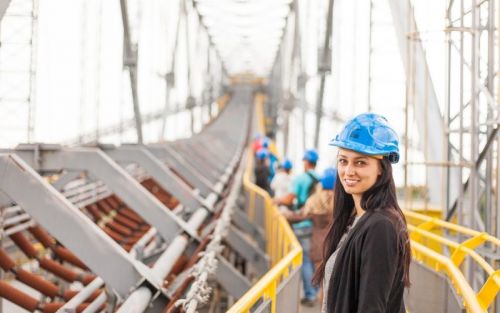
In the captivating realm of construction, the convergence of technology and physicality takes center stage through GPS breadcrumbing and geofencing.
Imagine invisible perimeters that shape and enhance every facet of the building process.
From safeguarding restricted zones to orchestrating the synchronized dance of heavy machinery, geofencing’s real-world applications in construction are rewriting the blueprint of efficiency and precision.
Join us as we delve into the dynamic world where virtual boundaries meet bricks and mortar, revolutionizing the industry one digital fencepost at a time.

Geofencing has emerged as a vital tool within the construction industry, weaving digital innovation into the fabric of building projects.
Its importance lies in the transformative capabilities it brings to various aspects of construction, encompassing safety, efficiency, and management:
Construction sites are often complex and potentially hazardous environments. Geofencing empowers project managers to establish virtual safety zones within which only authorized personnel can operate. This prevents unauthorized access, reduces the risk of accidents, and safeguards both workers and the public.
Geofencing acts as a virtual security guard, alerting stakeholders to any breach of the predetermined boundaries. This curbs theft, vandalism, and unauthorized entry, fostering a secure environment for valuable equipment and materials.
Tracking and managing construction equipment can be challenging. Geofencing allows real-time monitoring of equipment movement, ensuring machinery remains within designated areas and minimizing the chance of loss or theft.
By monitoring the movement of personnel and equipment, geofencing enables efficient allocation of resources. It helps prevent overlaps and optimize workflows, saving time and reducing operational costs.
Construction sites often have zoning regulations and environmental restrictions. Geofencing can ensure that construction activities remain within legally defined boundaries, helping companies avoid fines and legal complications.
Geofencing provides project managers with a bird’s-eye view of site activity, helping them monitor progress and identify bottlenecks. This real-time insight enables prompt decision-making to keep projects on track.
Geofencing can trigger automated processes based on location data triggers. For instance, a vehicle entering a specific zone could automatically alert the project manager or initiate a specific task.

Communication is pivotal in construction. Geofencing aids in setting up communication channels that activate when workers enter specific zones, ensuring timely information sharing and coordination.
Geofencing can also be utilized to monitor and manage environmental concerns. For instance, it can help ensure that construction activities do not encroach upon protected areas or disturb wildlife habitats.
The data collected through geofencing can be analyzed to identify patterns, optimize workflows, and make informed decisions that improve overall project performance.

Geofencing’s importance in construction is its ability to overlay digital intelligence onto physical spaces.
Here are a few real-life case studies showcasing how geofencing has been applied in the construction industry:
Clark Construction, a major construction firm, implemented geofencing to enhance construction site safety. They created virtual safety perimeters around hazardous areas and equipped workers with wearable devices. If a worker enters a geofenced danger zone, both the worker and management receive real-time alerts, helping prevent accidents.
Balfour Beatty, a global construction company, uses geofencing to manage their equipment fleet efficiently. They implemented geofences around their construction sites and equipment yards. If equipment leaves these zones without authorization, alerts are triggered, reducing the risk of theft.
Skanska, a construction company, employs geofencing for project management. They set up geofences around specific project areas and utilize them to track the movement of materials, equipment, and personnel. This data-driven approach helps optimize workflows and resource allocation.
Hensel Phelps, a construction firm, uses geofencing to streamline subcontractor coordination. They implement geofences around different work zones and subcontractor areas. When a subcontractor enters a designated zone, notifications are sent to project managers, aiding in seamless coordination.
Gilbane Building Company utilizes geofencing for real-time progress monitoring. They track when workers and equipment enter and exit these zones by setting up geofences around different project stages. This data is used to measure progress, identify delays, and make informed decisions.
AECOM, a multinational engineering firm, employs geofencing for site security. They establish virtual perimeters around their construction sites. If unauthorized personnel or vehicles enter these zones, security personnel are alerted, enabling prompt response and safeguarding the site.
Mortenson Construction uses geofencing to improve communication on complex projects. They create geofenced zones around specific project areas. When workers enter these zones, automated notifications are sent to inform them about changes, updates, and safety protocols.
These examples illustrate how various construction companies harness geofencing technology to optimize their projects’ safety, resource management, compliance, and communication.

Geofencing has transcended its digital boundaries in the dynamic construction world to reshape the industry’s landscape.
These real-life case studies vividly illustrate the multifaceted applications of geofencing, cementing its role as a transformative force.
From bolstering jobsite safety to optimizing resource allocation and enabling seamless communication, geofencing has become an indispensable tool for construction companies striving for efficiency and innovation.
The stories of companies like Clark Construction, Balfour Beatty, and Skanska demonstrate that geofencing isn’t just a technology but a strategic solution that enhances every facet of construction. It safeguards workers, prevents theft, streamlines operations, and fosters collaboration.
MobiClocks offers a transformative solution to implement geofencing seamlessly within your workforce through its innovative GPS breadcrumbing app.
With MobiClocks, you can create virtual perimeters around designated job sites, ensuring accurate employee time management based on their physical presence. This enhances payroll accuracy and provides real-time insights into on-site activities.
You can get this app on multiple devices, including your tablets and mobile devices!
By harnessing geofencing technology, MobiClocks empowers businesses to optimize resource allocation, improve accountability, and streamline project management, all while promoting transparency and compliance.

There are a lot of ways to deal with no call, no show employees. The policies you enforce will depend on the type of manager you are.

Naturally, productivity and work ethics are positively and strongly correlated. There are many ways to set up a work environment where ethics are valued, and one of the most effective ways has proven to be guidance and empowerment. If you are ready to tak

Having an employee handbook is essential to the efficient operations of your business. In general, it contains all the procedures and policies that go on in your firm. It’s vital to have one, especially in construction companies, where logistics plays a h